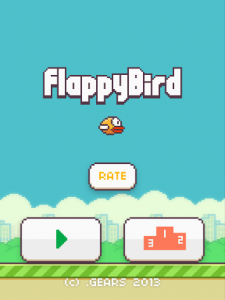Flappy Bird, for those of you who don’t know, was a smartphone game where users had to try and get a bird through as many obstacles as possible. I say had, as the app has been removed from the iTunes and Google Play – more on that later. I’m not sure I can really explain it much better than that, so take a look at this video to see it in action.
As you can see people take this game pretty seriously. The chap says how he has been playing it for about a week and that “it has totally consumed [his] life“. I tried the game on a friends phone and sensing that it was something that I was likely to get addicted to I decided not to install it myself. I am very glad I made that decision. In fact I have decided to take a total detox from all smartphone and tablet apps recently, and it really does feel great.
 Usually I install an app when I have some time to kill, but after a while, I seem to be wasting far too much time on pointless apps. I took a step back and saw that playing games such as Flappy Bird was just a waste of my time. This article is not asking you to stop using apps, but I do want to make people think.
Usually I install an app when I have some time to kill, but after a while, I seem to be wasting far too much time on pointless apps. I took a step back and saw that playing games such as Flappy Bird was just a waste of my time. This article is not asking you to stop using apps, but I do want to make people think.
I want to make people think, much in the same way that I suspect Dong Nguyen wants to make people think. Dong Nguyen was the creator of Flappy Bird and despite the fact that some sources report the game to have been earning around $50,000 per day in ad revenues, he took it down. The game was very addictive and didn’t really add any value to the lives of players. If anything, for many it just caused a lot of stress and aggravation.
Anyone who downloaded the game still has it, but if they uninstall it it is gone forever. Some people are selling their handsets with the game still installed on it, although many manufacturers advise against this on privacy grounds.
What I want to know – in the comments below – is what are your opinions? Was the developer right to remove the game? As a society are we getting more addicted to such games? If so, how are they affecting culture – or are they just a bit of harmless fun?
Oh and folks, please don’t go taking a hammer to your phone. 🙂


